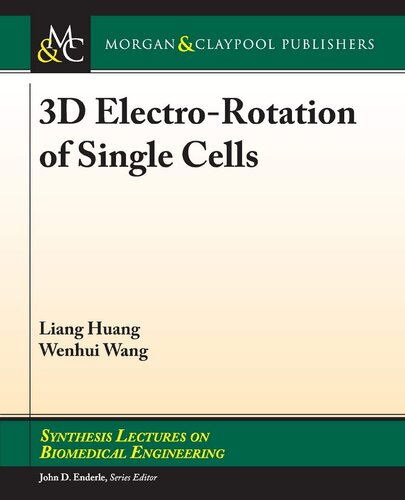الکتروفورز سه بعدی تک سلولی ۲۰۱۹
3D Electro-Rotation of Single Cells 2019
دانلود کتاب الکتروفورز سه بعدی تک سلولی ۲۰۱۹ (3D Electro-Rotation of Single Cells 2019) با لینک مستقیم و فرمت pdf (پی دی اف)
| نویسنده |
Liang Huang, Wenhui Wang |
|---|
| تعداد صفحهها |
119 |
|---|---|
| نوع فایل |
|
| حجم |
7 Mb |
| سال انتشار |
2019 |
89,000 تومان
معرفی کتاب الکتروفورز سه بعدی تک سلولی ۲۰۱۹
تراشه های میکروسیال دی الکتریک به دلیل مزایای عملکرد راحت، توان عملیاتی بالا و هزینه کم به طور گسترده در بسیاری از کاربردهای بیولوژیکی استفاده می شوند.
با این حال، اکثر تراشه های میکروسیال DEP مبتنی بر الکترودهای مسطح دوبعدی دارای محدودیت هایی مانند تضعیف میدان الکتریکی، مناطق کوچک کار موثر و نیروهای ضعیف DEP هستند. به منظور غلبه بر محدودیت های الکترودهای مسطح دو بعدی، دو نوع تراشه DEP با الکترودهای ضخیم برای تحقق پردازش چند پارامتری و اندازه گیری سلول های تک طراحی شدند.
بر اساس ساختار چند الکترودی الکترود DEP با دیواره ضخیم، یک تراشه الکتروریسی تک سلولی سه بعدی “Armillary Sphere” طراحی شده است. این تراشه از چهار الکترود ضخیم و یک الکترود مسطح پایینی برای تشکیل یک محفظه میدان الکتریکی استفاده می کند که می تواند چرخش سه بعدی سلول های منفرد را تحت پیکربندی های سیگنال الکتریکی مختلف کنترل کند. اندازه گیری خواص الکتریکی و بازسازی تصویر سه بعدی سلول های تک بر اساس چرخش سه بعدی تک سلولی به دست می آید. این کار بر محدودیت های الکترودهای مسطح دوبعدی غلبه می کند و به طور موثر مشکل موقعیت مکانی ناپایدار نمونه های تک سلولی را حل می کند و بستر جدیدی برای تجزیه و تحلیل تک سلولی فراهم می کند.
بر اساس ساختار DEP الکترود ضخیم چند الکترود، یک تراشه میکروسیال با ادغام فوتوالکترونیک معرفی شد. برانکارد فوتونیک دو فیبر تعبیه شده در الکترودهای ضخیم می تواند یک سلول را به دام بیاندازد و بکشد در حالی که الکترودهای ضخیم تر برای چرخش تک سلولی استفاده می شوند. دستکاری کشش و چرخش ویفر توانایی اندازه گیری همزمان خواص مکانیکی و الکتریکی تک سلولی را می دهد، بستری همه کاره برای آنالیز تک سلولی فراهم می کند و کاربرد DEP ضخیم را در پردازش و آنالیز بیولوژیکی گسترش می دهد.
Dielectrophoresis microfluidic chips have been widely used in various biological applications due to their advantages of convenient operation, high throughput, and low cost.
However, most of the DEP microfluidic chips are based on 2D planar electrodes which have some limitations, such as electric field attenuation, small effective working regions, and weak DEP forces. In order to overcome the limitations of 2D planar electrodes, two kinds of thick-electrode DEP chips were designed to realize manipulation and multi-parameter measurement of single cells.
Based on the multi-electrode structure of thick-electrode DEP, a single-cell 3D electro-rotation chip of "Armillary Sphere" was designed. The chip uses four thick electrodes and a bottom planar electrode to form an electric field chamber, which can control 3D rotation of single cells under different electric signal configurations. Electrical property measurement and 3D image reconstruction of single cells are achieved based on single-cell 3D rotation. This work overcomes the limitations of 2D planar electrodes and effectively solves the problem of unstable spatial position of single-cell samples, and provides a new platform for single-cell analysis.
Based on multi-electrode structure of thick-electrode DEP, a microfluidic chip with optoelectronic integration was presented. A dual-fiber optical stretcher embedded in thick electrodes can trap and stretch a single cell while the thick electrodes are used for single-cell rotation. Stretching and rotation manipulation gives the chip the ability to simultaneously measure mechanical and electrical properties of single cells, providing a versatile platform for single-cell analysis, further extending the application of thick-electrode DEP in biological manipulation and analysis.




